If Midwestern
places are so grim and gray, why do writers keep recalling
them, sometimes after decades of living far away? What draws
the imagination back across the miles and years? The chief
lure is the country itself; the forests, fields, and prairies,
the wandering rivers, wide skies, dramatic weather, the
creekbeds lined with sycamores and limestone, the grasses
and flowers, hawks and hickories, moths and cicadas and
secretive deer. Again and again in literature about the
Midwest you find a dismal, confining human realm –
farm, village, or city – embedded in a mesmerizing
countryside… By turns cruel and comforting, the land
holds them, haunts them, lingers in their memory and bones.
Scott Russell Sanders
Writing from the Center
Scott Russell Sanders is one of the nation’s
leading voices in environmental concerns. Born in 1945 in
Memphis, Tennessee, Sanders moved to Ohio at the age of five.
He was exposed to many contrasting environments in his childhood,
from the farm in Tennessee where he was born to a military
arsenal in Ohio. He left the Midwest in 1963 to attend Brown
University in Providence, Rhode Island, and then earned his
Ph. D in English literature at Cambridge University as a Marshall
Scholar. In 1971, Sanders and his wife Ruth moved to Bloomington,
Indiana, where he still teaches at Indiana University as a
Distinguished Professor of English. By the time he moved to
Indiana, he had lived in seven states and two different countries.
When Sanders moved to Bloomington
in 1971, he did not take the idea of settling into a new community
lightly. In his book Secrets of the Universe,
he writes of his determination to become acquainted with the
surrounding countryside: “[W]ishing to know the place
where I have been set down, I drive the back roads of Indiana,
tramp across country, wade the streams, look about" (86).
Many of his main themes in writing stem from this awareness
of the environment and sense of place. Humanity’s role
in nature, both positive and negative, is often explored in
his essays, very often in the context of contrasts.
In an interview
with the Kenyon Review, he spoke about these
reoccurring themes in his work:
The contrasts and tensions arise from my life
– North/South, country and city, militarism and pacifism.
Living as a boy in an arsenal in Ohio, I felt a fierce contrast
between the fruitfulness and wildness of nature, on one
hand, and the ingenuity and destructiveness of technology,
on the other… As a writer I keep seeing these contrasts…
and maybe I’m still trying to bring the two poles
together, to reconcile enemies.
The most apparent poles in his work are nature
and humanity. Sanders revels in the celebration of the earth
and the resilient strength of nature, while mourning the destruction
that humanity has created. Though his essays have various
focuses and themes, the thread that holds everything together
is his celebration of the earth and his ability to capture
and rejoice in the smallest details of his surroundings. Scott
Russell Sanders is deeply affected by his surroundings, and
is a passionate product of his environment.
Overall, Sanders celebrates the beauty of nature.
Every detail is noticed and appreciated, and this attention
to intricacy fills his essays with vivid descriptions of his
surroundings. Sanders’ environment is deeply intertwined
with his life and his writing, and many times the countryside
is where he receives solace and inspiration. In his book Secrets
of the Universe, the joy of returning to familiar countryside
is obvious, "After a year in the bunched-up terrain of
New England, I was amazed by the extent of sky, the openness
of the land, the vigor of the head-high corn, the loneliness
of the farmsteads, the authority of those clouds" (84).
 |
Indiana
corn |
Sanders writes often of the
prairies
of Indiana, with vivid descriptions of tall-grass prairies
and the life that teems within them:
…[B]irds fill this blustery June afternoon
here in southern Indiana.
We see goldfinches dipping and rising as they graze among
the waving seed heads of the tall grasses. We see red-winged
blackbirds clinging to the tops of cattails that sway in
the breeze. We see a kettle of hawks, a swirl of starlings,
a fluster of crows. A great blue heron goes beating by,
and six or eight geese plow the ruffled waters of a lake.
(Force 17)
In The Force of Spirit,
Sanders also writes of the prairie:
In every season the prairie is lovely beyond
words. It supports a wealth of wildlife, resists diseases
and pests, holds water, recycles fibers, fixes nitrogen,
builds soil. And it achieves all of that while using only
sunlight, air, snow, and rain. (51)
Nature is used as a vivid
setting for himself and also as an inspiration for his reflections.
In the essay “Sanctuary” in Writing
from the Center, Sanders writes about visiting
Clear Creek, just outside Bloomington.
Clear Creek is a common refuge for him, and this nature preserve
is often a setting for Sanders to reflect and collect his
thoughts.
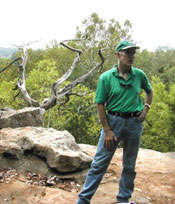 |
Sanders
at Clear Creek |
I look out over the meadow and gather myself.
To my right, beyond a thicket of willows and sumac, I
see the glint of Clear Creek, whose occasional floods
keep this bottom land from turning to forest. The bluff
rises on my left, dense with oak and maple and cedar everywhere
except for a broad swath cut by the right-of-way for high-tension
lines. (53)
The contrasts
of humanity and nature concern him, even
when he retreats to nature to regroup. Even at Clear Creek,
humanity’s alterations of this bluff catch his attention
and cause him to write not only about the beauty he sees,
but also the ugliness that people have inflicted upon nature:
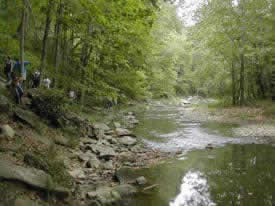 |
Clear Creek |
This bright thread glistening before me, the
sun-dappled creek, no longer runs clear, as it did when
the settlers named it. The water is murky with topsoil.
Mounds of dirty foam gather in the shallows…Less visibly,
more dangerously, the water
is fouled with fertilizer, pesticides, herbicides, solvents,
oil. (53)
Likewise, in Staying Put, Sanders
discusses the Ohio River,
the southern boundary of Indiana:
Swimming in the Ohio, I try to feel all the
remotest creeks of that vast basin trickling through me.
I like to imagine I can smell in the river the pines from
the mountains, the oaks and hickories of the foothills,
the blackberries and wildflowers of the bottomlands. What
I’m likelier to smell is diesel
oil, cotton poison, coal slurry, or sewage, because
twenty-five million people live in the basin, and the watercourses
are lined with towns, factories, mills, slag heaps, power
plants, and refineries. Like the rest of our planet, the
Ohio is caught in a tug-of-war between natural influences
and human ones. (63)
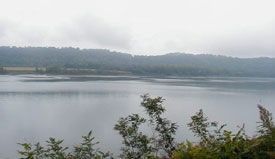 |
Ohio River |
Sanders thus juxtaposes humanity and nature to
create awareness of peoples’ effects on the land.
Time and again, the effects of pollution are
discussed in Sander’s work. From water
pollution to chemical leaching into the soil, Sanders
repeatedly highlights the effects of the environment’s
widespread contamination.
When I look at the filth
along parts of the Ohio, when I consider the annihilation
of forests
and the disappearance of wildlife, I cannot agree that such
brief profit justifies so much desolation. Since the earliest
days, the river
has been used as a dump, receiving offal from slaughterhouses,
sewage from towns, manure from livestock pens, mash from
breweries, waste from factories and mines. Little was done
to control pollution of the Ohio until the last few decades,
and we are still a long way from having cleaned up our mess.
This, too, is part of the river’s history, the tar
and chemicals, the oil slicks, the squandering within a
few generations of an unforeseen, unearned bounty. (82)
When researching for his
book Stone Country, Sanders encountered
local stories of pollution in the limestone quarries that
are located around Bloomington:
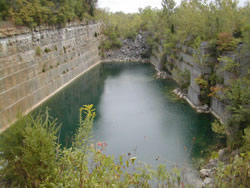 |
| Empire
State limestone quarry |
In the 1970s he [Ed Bennett, a quarry owner]
permitted the dumping of some electrical capacitors in one
of his quarries, and the fluids leaking from those capacitors
were poisoning the neighborhood with polychlorinated biphenyls
– PCBs – recently added to the Environmental
Protection Agency’s hit list of deadly chemicals…
Among the PCB dumps in America, the quarry named after Ed
Bennett was one of the dirtiest and most dangerous. A year
before our visit, technicians in breathing gear and bubble
helmets and snowy protective suits… had poked around,
hauled away a few truckloads of leaking capacitors, filled
the hole with fresh dirt, capped it with plastic, fenced
it off, planted it with grass, and declared the three acres
site "stable." (60,65)
His frustration with the pollution is often compounded
with the way that people handle the situation. “A man
who’d worked on the fencing crew told me that, when
driving posts, they kept running into buried capacitors. Eventually
they got fed up and returned to the original boundary"
(Stone 65). Even though people were aware of the
dangers of the PCBs, laziness and lack of foresight still
drove them to compromise the quality of the soil and the surrounding
communities.
Destruction of the natural landscape is also
a recurring contrast in Sanders’ essays. In Secrets
of the Universe, he graphically illustrates the lasting
effects that people have had upon the land:
 |
Indiana
dunes on Lake Michigan |
I also know from books that, except for dunes
and prairies and swamps
near Lake Michigan, all of what would become Indiana was
dense with forest when the first white settlers arrived.
This means that almost every acre of soybeans and corn represents
an acre of trees cut down, stumps pulled out or left to
rot: oak and beech, hickory and maple, dogwood, sassafras,
buckeye, elm, tulip poplar, ash. In two centuries, a mere
eyeblink in the long saga of a planet, Indiana has been
transformed from a wilderness dotted by human clearings
to a human landscape dotted by scraps of wilderness. Today,
only the southern third of Indiana is heavily wooded, but
the speed with which redbud and locust and cedars march
into abandoned pastures convinces me that the entire state,
left to itself, would slip into forest again within a few
decades. (91)
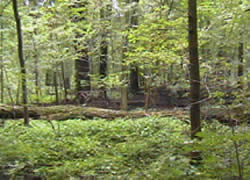 |
Ginn Woods,
an old growth forest |
Yet, while Sanders often
sees the negative human impact upon the land, he also has
a great deal of hope for people’s ability to undo what
has been done to the earth. In his book Hunting
for Hope, he reflects on the unusual opportunity
that people have in interacting with the land:
We are the only species capable of exterminating other species
wholesale, but we’re also the only one capable of
acting, through love and reason, to preserve our fellow
creatures. We are unique in our ability to affect the fate
of the planet, but also unique in our ability to predict
those effects and to change our ways in light of what we
foresee. (133)
He believes that people need to take more responsibility
for the beauty and resources that we have been given, and
treat the land with respect.
Because we have achieved
an extraordinary power to impose our will upon the earth,
we bear a solemn obligation to conserve the earth’s
bounty, for all life. This means we should defend the air
and water and soil from pollution and exploitation. It means
that we should protect other species and preserve the habitats
on which they rely. For our own species, it means we should
bring into the world only those children for whom we can
provide adequate care, and then we should provide that care
lovingly and generously. (168)
Sanders’ writing is a celebration of his
surroundings, but also a reflection of the terrible damage
that we’ve wreaked upon the earth. Nonetheless, Sanders
does not end on a note of despair. He shares hope in the fact
that the fragility of the environment is becoming a concern.
He conveys faith that people are beginning to take responsibility
for their actions and the actions of others. He expresses
confidence that people have an amazing ability to heal what
was done in the past. And ultimately, he takes joy in the
power of nature to respond to our efforts.
Right now, in hundreds of places across the
United States and other countries, people are at work returning
animals and plants to areas from which they had vanished,
reflooding drained wetlands, gathering rare seeds, replanting
forests and prairies, cleaning up rivers, helping endangered
species and battered lands to recover… Instead of
merely grieving over what has been lost, these dedicated
people…are working to reverse the devastation. They
are reweaving the torn fabric of life. (37)
--SKL
Sources:
Sanders, Scott Russell.
"Something Durable and Whole." The Kenyon Review
21.1 (2000) <http://www.kenyonreview.org/Magazine/interviews/pz-sanders.asp>.
Sanders, Scott Russell.
The Force of Spirit. Boston: Beacon Hill, 2000.
---. Hunting for
Hope. Boston: Beacon Hill, 1998.
---. Secrets of the
Universe, Scenes from the Journey Home. Boston: Beacon
Hill, 1991.
---. Staying Put.
Boston: Beacon Hill, 1993.
---. Stone Country.
Bloomington: Indiana UP, 1985.
---. Writing from
the Center. Bloomington: Indiana UP, 1995.
Image:
"Scott Russell Sanders."
Milkweed Editions. 11 Dec. 2002. <www.milkweed.org/4_catalog/
4_1_5_2293.html>.
Links:
Bibliography
of Scott Russell Sanders
Sanders'
essay “Limberlost and Found”
Sanders'
essay “Stillness”
Sanders'
interview with Kenyon Review
|




